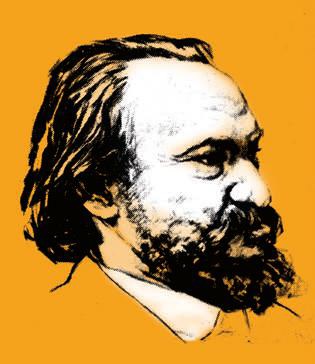Changing direction reduces wear
Drs. Wilfred T. Tysoe & Nicholas D. Spencer | TLT Cutting Edge April 2011
The Bauschinger Effect examines how abrasive wear between a pair of metal counterfaces is greater for unidirectional sliding.

Johann Bauschinger
(1834-1893)
It has long been known that the stress-strain properties of materials can depend on the way in which stresses are distributed microscopically within the material. This effect is known as the Bauschinger Effect, named after Johann Bauschinger (1834-1893), a mathematician and professor of engineering mechanics at the Technical University of Munich.
The Bauschinger Effect is frequently observed as a decrease in yield strength of metals when the strain direction is changed. The effect can be explained in terms of dislocation buildup in the material, which leads to strain hardening, and is reduced when the strain direction is reversed due to local reversible movement of dislocations and annihilation of dislocations with opposite signs.
The Bauschinger Effect has consequences for tribology, as has recently been reported in the STLE-affiliated journal,
Tribology Letters by C.Y. Tang, D.Y. Li and G.W. Wen of the University of Harbin in China and the University of Alberta in Canada. These researchers carried out wear experiments in a modified ASTM G65 tester by rotating a steel wheel loaded to 130N against a copper-zinc alloy surface.
During a given set of experiments, which were carried out for a fixed number of rotations, they varied the number of times the direction of rotation of the wheel was changed and looked for the influence of this quantity on wear, hardness and local structure, as measured by X-ray diffraction (XRD) and scanning electron microscopy (SEM).
The results showed that unidirectional sliding (i.e., no direction reversal of the wheel) led to up to 40% higher wear than cases where the rotation direction was reversed. Beyond five cycles of changing direction, the effect did not increase significantly. Overall, the Vickers’ hardness decreased as the number of direction-change cycles was increased. XRD measurements of unidirectionally vs. bidirectionally (50 cycles) worn surfaces showed negligible differences, suggesting that textural changes in the alloy did not play a major role in the wear differences.
On the other hand, subsurface cross-sections measured by SEM showed that the unidirectionally worn samples had suffered more severe fracture than the bidirectionally worn materials. Fracture involves the nucleation and propagation of cracks, which occur when stress concentrations exceed the critical stress at fracture. The stress concentrations arise when dislocations of the same sign interact with each other, piling up at interfacial boundaries.
Due to the Bauschinger Effect, local reversible movement of dislocations may occur, and the number of dislocations is reduced in bidirectional sliding as dislocations become annihilated by dislocations of opposite sign, which arise from sliding in the opposite direction. Furthermore, bidirectional sliding may not only reduce crack formation, it also may slow crack propagation since the stress driving the crack is also reversed.
There are interesting consequences of these observations. First, design of machines that minimize unidirectional in favor of bidirectional sliding could lead to reduced wear. Secondly, abrasive processes used for manufacturing could be improved if unidirectional sliding were favored over bidirectional sliding.
FOR FURTHER READING:
Tang, C.Y., Li, D.Y. and Wen, G.W. (2011), “Bauschinger’s Effect in Wear of Materials,”
Tribology Letters,
41(3), pp. 569-572.
Sowerby, R., Uko, D.K. and Tomita, Y. (1979), “A Review of Certain Aspects of the Bauschinger Effect in Metals,”
Materials Science and Engineering,
41 (1), pp. 43–58.
Yue, L., Zhang, H. and Li, D.Y. (2010), “Defect Generation in Nano-Twinned, Nano-Grained and Single-Crystal Cu Systems Caused by Wear: A Molecular Dynamics Study,”
Scripta Materialia,
63, pp. 1116–1119.
 Eddy Tysoe is a Distinguished Professor of Physical Chemistry at the University of Wisconsin-Milwaukee. You can reach him at wtt@uwm.edu
Eddy Tysoe is a Distinguished Professor of Physical Chemistry at the University of Wisconsin-Milwaukee. You can reach him at wtt@uwm.edu.
 Nic Spencer is professor of surface science and technology at the ETH Zurich, Switzerland. Both serve as editors-in-chief of STLE-affiliated Tribology Letters journal. You can reach him at nspencer@ethz.ch
Nic Spencer is professor of surface science and technology at the ETH Zurich, Switzerland. Both serve as editors-in-chief of STLE-affiliated Tribology Letters journal. You can reach him at nspencer@ethz.ch.